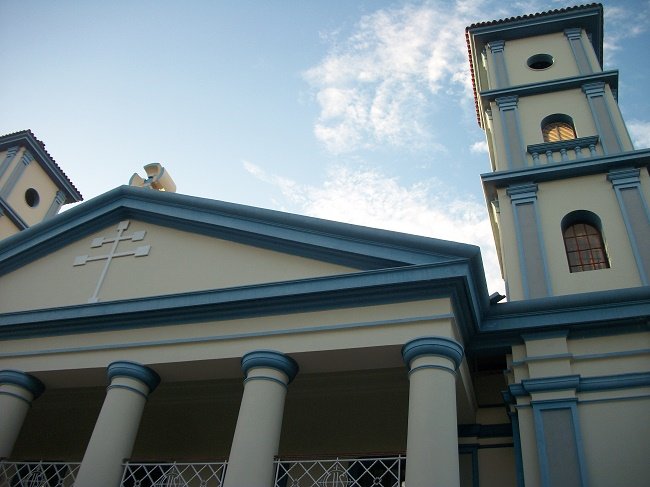Ahora que estamos entrando en la Navidad, en sentido estricto, obviamente vinculada al sentido religioso cristiano, me pareció acorde publicar unas fotos que hice recientemente de la Catedral Metropolitana de Cumaná, así consagrada en 1989. Es un templo católico, por supuesto, que, luego de haber sido destruido por el terrible terremoto de 1929, fue levantado nuevamente en 1936 por el obispo de entonces, Mons. Breckman; de él no hay mucha información, pero se dice que diseñó los planos y que, incluso, trajo madera de un pueblo de Sucre llamado Cariaco para la estructura de la iglesia, así como los retablos de origen español (muy hermosos, por cierto) que la ornan. (ver aquí).

La Catedral de Cumaná ocupa un lugar primigenio y de gran significación en mi vida. Cuando niño y adolescente (entre los 8 y 14 años, aproximadamente) fui acólito en esa iglesia. Me nutrí de sus espacios, sean altares, retablos, vitrales, lámparas ("arañas" las llaman), techos (de una belleza particular lograda en madera), etc., de un atractivo sumamente especial para quienes sepan apreciar aspectos como estos, si bien de origen religioso, de una presencia o fondo artístico indiscutible.
También ahí inicié una disciplina acerca del orden de las cosas y sus cuidados; son muchos los implementos a tener en cuenta y cuidar (cálices, vestiduras...). Quizás de allí me viene mi gusto por los aromas orientales, pues una de las prácticas que más me gustaba era encender el incensario, colocar las piedras de mirra e incienso e incensar al sacerdote y a los feligreses.
Si algo amé, en especial, fueron sus torres y los campanarios. Las campanas de esta iglesia son de las que llaman de "vuelo", o al viento; es decir, campanas que se mueven (no solo el badajo), y en ese movimiento producen el sonido al tocar el badajo de ida y vuelta; lo cual puede ser de gran efecto sonoro, si se accionan con gran fuerza.
Esa, como decía, fue de mis mejores experiencias como acólito. Me maravillaba poder suspenderme en el aire, aunque fuera unos instantes, al jalar la cuerda de la(s) campana(s), y mientras más tiempo, mejor. Subir las escaleras hasta donde estaban las campanas, bien fuera para tratar de arreglar algo, o simplemente para tener la experiencia sonora de estar allí, escuchando aquel sonido sordo de la vida, fue otro de esos pequeños placeres. Y las campanas siguen ahí.
Click here to read in english
Chronicle and photographic view of the Cathedral of Cumaná (own photos)
Now that we are entering Christmas, in the strictest sense, obviously linked to the Christian religious sense, I thought it appropriate to publish some photos I recently took of the Metropolitan Cathedral of Cumana, thus consecrated in 1989. It is a Catholic temple, of course, which, after having been destroyed by the terrible earthquake of 1929, was rebuilt in 1936 by the bishop at the time, Monsignor Breckman; there is not much information about him, but it is said that he designed the plans and that he even brought wood from a town in Sucre called Cariaco for the structure of the church, as well as the altarpieces of Spanish origin (very beautiful, by the way) that adorn it. (see here).
The Cumaná Cathedral occupies a primordial and highly significant place in my life. As a child and adolescent (between the ages of 8 and 14, approximately) I was an acolyte in that church. I was nourished by its spaces, be it altars, altarpieces, stained glass, lamps ("chandeliers" they call them), ceilings (of a particular beauty achieved in wood), etc., of an extremely special attraction for those who know how to appreciate aspects such as these, although of religious origin, of an indisputable artistic presence or background.
There too I began a discipline about the order of things and their care; there are many implements to take into account and care for (chalices, vestments...). Perhaps that is where my taste for oriental aromas comes from, since one of the practices that I liked most was lighting the censer, placing the stones of myrrh and incense and incensing the priest and the parishioners.
If there is one thing I loved, in particular, it was its towers and bell towers. The bells in this church are the so-called "flying" or wind-operated ones; that is, bells that move (not just the clapper), and in that movement they produce the sound by ringing the clapper back and forth; which can have a great sound effect, if they are operated with great force.
That, as I said, was one of my best experiences as an acolyte. I was amazed to be able to suspend myself in the air, even for a few moments, by pulling the rope of the bell(s), and the longer the better. Climbing the stairs to where the bells were, either to try to fix something, or simply to have the sound experience of being there, listening to that dull sound of life, was another of those small pleasures. And the bells are still there.









Referencias | References:
https://es.wikipedia.org/wiki/Catedral_de_Cuman%C3%A1
https://www.instagram.com/memoriasdecumana/p/BpUFHfHgpTI/?img_index=1





I loved your story. The way you’ve tied your personal memories with the cathedral is amazing. Those bell experiences sound epic and the photos really bring the place to life. Thanks for sharing 😊
Thank you for your visit and your warm comment. Best regards, @ellie-mai.
@commentrewarder
Encantador post, tanto por el texto como por las fotos excelentes de la estructura del templo!... Gracias por compartir amigo @josemalavem!
!discovery 35
!PIZZA
Gracias a ti, @jlinaresp, por tu visita y tu valoración. Saludos.
@commentrewarder
$PIZZA slices delivered:
@jlinaresp(9/15) tipped @josemalavem
This post was shared and voted inside the discord by the curators team of discovery-it
Join our Community and follow our Curation Trail
Discovery-it is also a Witness, vote for us here
Delegate to us for passive income. Check our 80% fee-back Program
Thanks, @discovery-it.
Thanks, @visualshots.